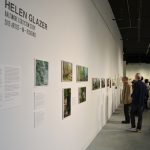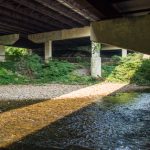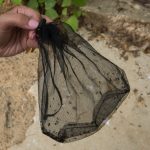A National Science Foundation Urban Ecology Research Study
The photographs and sculpture shown here come from a yearlong residency as the Baltimore Ecosystem Study (BES) artist-in-residence for 2014-15. The BES is part of a network of 28 long-term ecological research (LTER) sites funded by the National Science Foundation, and one of only two LTER sites to focus on urban ecology. The main focus of long-term data collection is the Gwynns Falls watershed, which extends from rural woodlands into the heavily urbanized west side of Baltimore City, where it eventually empties into the harbor. In order to find these places and understand their significance within the concerns of ecologists, I hiked along urban streams with hydrologists, visited the site of a major landslide due to storm water runoff, and walked the back alleys of impoverished neighborhoods with the Baltimore Mosquito Study. These places are seldom noticed or visited by most Baltimoreans, despite being in the midst of a heavily populated region. I was often startled by what I saw. Part of my goal is to serve as intermediary between the scientists and the public, to communicate what I learned to a general audience.
Listen to a radio interview on the Baltimore Ecosystem Study that I participated in, originally broadcast March 2016 on the Marc Steiner Show, WEAA-FM, a Baltimore NPR station.
See selected photographs, a sculpture, and other exhibition photos and detailed project description below.


Art and the Baltimore Ecosystem Study
Space Camp Gallery, Baltimore
October 3-30, 2015





archival pigment prints












antique map and Google Earth view










acrylic on 3D printed plastic
18 x 18 x 2 inches

The Baltimore Ecosystem Study is so wide-ranging and complex, comprising so many different topics, that it was a huge challenge to synthesize it into a coherent story. I'm an artist, not a reporter, historian or scientist, so although I sometimes apply those approaches to this exhibition, the pieces here represent my subjective and personal take on the topic. They record moments that drew my eye with their striking visual qualities and that provoked an emotional response, usually a combination of two or more from this list: curiosity, wonder, amazement, ironic humor, appalled, sad, or feeling what philosophers of art call the sublime — awe at nature's power to create and destroy.
As an artist interested in natural forms and the landscape, a major benefit of accompanying scientists in the field was learning to recognize and understand details that I would otherwise overlook or whose significance would escape me. Part of my goal in presenting the work to the public is that they will start noticing, too. We all have a stake in caring for our waterways and supporting and advocating efforts by our government officials to preserve and improve it, including investing our tax dollars in such things as storm water management, updating sewer lines, improving impoverished neighborhoods and caring for open space. We are all part of the ecosystem.
The Baltimore Ecosystem Study is multidisciplinary and complex, so finding a unifying theme for an art project was challenging. I attended the researchers' quarterly meetings, listened to their presentations and discussions, and accompanied some of them into the field where they collected samples and realized that within the environmental sciences, the focus on urban environments is relatively novel. Urban ecology invites us to consider the places where most of us actually live as ecosystems, with our infrastructure and buildings as an integral part. BES scientists study how human activity affects nature and vice versa within the particular climactic and geological conditions of metropolitan Baltimore. As an artist interested in natural forms and the landscape, I found this idea provocative. I realized that when we talk about "the natural," using such terms as "pristine wilderness," and "unspoiled landscape," this not only erroneously implies that we are not there but that our presence on earth falls into the category of "unnatural." Those assumptions ignore the reality we actually live in. I believe that if we want to find a way forward to a sustainable future we all — all of us, not just scientists — need to reframe our concept of nature to include human decisions and their consequences. Therefore, my project documents the results of interactions between nature and human activity, within the Gwynns Falls watershed.


